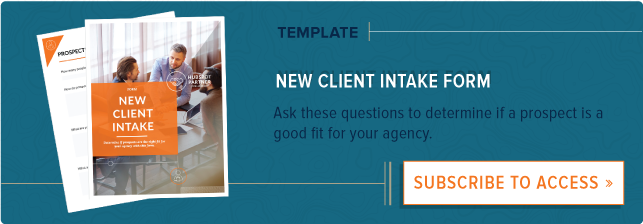Profit: It's one little word that can make or break an agency.

As with any service-based business, agencies have a limited number of billable hours in the week per employee. So when profits are lower than expected -- or even just lower than you’d like -- most agency owners immediately think about raising their rates.
Raising your rates is a great option for increasing profits, but before you take that step, there are a few other things to consider when it comes to both strategy and tactics.
1) Are You Making This Profit-Killing Mistake?
As a consultant working with agencies, I’ve found that the fastest way to increase an agency’s profits is often to raise its sales estimates rather than its prices.
For example, I had a client who took on a client for a $100,000 annual retainer. When we looked at the amount of work her team was actually doing for that client, it turned out they was providing $200,000 worth of services and not getting paid for half their work!
If her team had estimated the work better -- and pushed back on out-of-scope requests -- the work would have been profitable at the regular rate.
Another client was charging $3,500 per month for an online marketing retainer. After I did a work breakout (WBO) session with them, we found that they were delivering $5,000 in work without being paid for the additional work.
In both cases, the agencies could increase profits faster by doing better estimates.
2) How Does Your Agency Stack Up? Your Rate Versus the Competition
If you determine that your estimates are relatively accurate, and you still want to raise your rates, the next thing to do is compare your rate to the market rate.
If your rate is below market rate, you should almost definitely raise your rates. And if you are a specialist working with specific client industries, your agency can reasonably charge above-the-market rates due to that expertise.
However, if you’re at the going market rate (or above it) already, you should commit to improving the positioning of your agency before charging more.
3) Where Does Your Pricing Come From? A Look at Your Pricing Model
Once you’ve determined how your rates stack up to the competition, it’s time to re-evaluate where your rates came from in the first place.
What is your rate based on? Is it time and materials? Do you offer fixed-bid pricing for fixed-scope work? Or do you use a value-based pricing model?
For most agencies, value-based pricing will be the most profitable. Why?
If your rate is based on time and materials, you’re literally exchanging time for money -- all your estimates are based on a base hourly rate. That means you have a finite number of billable hours per employee that you can sell before you have to hire more staff or your profits hit a plateau.
If you use fixed-bid pricing, you have set prices per project time that you use, almost like a fast food menu. If a client wants to add social media services, you have a standard rate for that. If they need a landing page, again, you have a standard rate. It’s almost as if your clients were simply ordering off of a menu. This is regardless of how much actual time a project might take if you can manage scope and client expectations up front.
However, if you use value-based pricing, your prices reflect the actual value the client gets from the project you create. This can be a bad thing if you’re doing low-value work, but if you can demonstrate the value a new website or a new landing page will offer a client, it can allow you to significantly increase the amount you charge.
4) Choosing the Right Strategy for Raising Rates
In No, 2, you compared yourself to the competition. The relationships you have with your existing clients will impact the process you’ll use to raise your rates.
If your agency only has weak relationships with existing clients, and clients can easily exchange you for one of your competitors, you’ll have trouble raising your rates with current clients. Therefore, the best strategy may be to only raise rates with new clients, since they don’t have an existing reference point.
However, if your agency has strong client-relationships and is highly valued by your clients, recognize that you have power in your pricing strategy. Your clients know the value your agency provides and are likely to accept the increase in price. As a result, you can probably move them over to your new rate, either by introducing the rate the next time they request a project or all at once -- with some advance notice.
5) Having the Talk With Your Client
For new clients, the process will be as simple as sending them a proposal with your new rate and describing what your pricing model is.
For an existing client, the best time to introduce them to your new rate is when they request new work or when they renew their retainer. This conversation gives you an opportunity to sell them on doing the work they requested at a higher rate. They are already primed to say “yes”, even if they don’t know the dollar amount.
Another option for implementing higher rates for existing clients is to offer them a “deal.” Email them a few months before you plan to increase your rates. Let them know about the planned rate increase, but tell them that because they’re long-standing, highly valued clients, you want to give them a deal: any work they book between now and then will be priced at the old rate, even if the actual project won’t be finished by that date, but once that date hits, any new projects will be booked at the new rate.
This is often a great way to get long-time clients to book work out into the future, and it ensures that any clients that do choose to jump ship because of your increased rates don’t impact the viability of your agency's financials.
Value Trumps Pricing Every Time
You will need to apply each of the above steps on a client-by-client basis. Some clients may not accept higher rates, and you will have to decide which clients to keep and which to fire.
Perfecting your pricing isn't just about deciding on a number. It's about how your frame the value you provide to clients. This will require you to hone your communication, but in the end, you'll find your increased margins and profitability are worth it.









